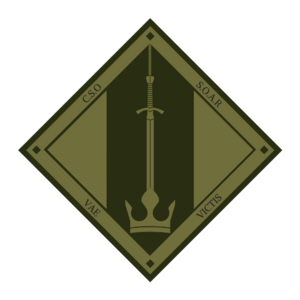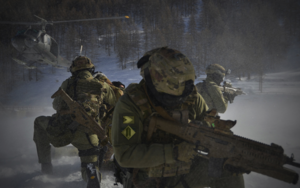Special Operations and Aggressive Reconnaissance
| Special Operations and Aggressive Reconnaissance Brigade | |
|---|---|
| Brigada dei Specialé Operación ét Agressivé Reconocimiento | |
 SOAR insignia, known as the "Sword of Damocles" | |
| Active | 12 September 1941 – present (82 years, 11 months) |
| Country | |
| Type | Special operations force |
| Role | Special operations Direct action Counter-terrorism Aggressive reconnaissance (Recce-in-force) Unconventional Warfare Hostage rescue Foreign internal defense Counter-proliferation |
| Part of | Special Operations Command (Iverica) Joint Special Warfare Division |
| Garrison/HQ | Site Sierra, Leon Military Zone |
| Nickname(s) | "The Boys in Black", "The Men with Pointy Knives", "The Brigade" |
| Motto(s) | Vae Victis (Aroman Latin) |
| Engagements |
|
The Brigada dei Specialé Operación ét Agressivé Reconocimiento (Anglish: Special Operations and Aggressive Reconnaissance Brigade), more popularly known as SOAR is the Republic of Iverica's direct action special forces unit. The brigade is activated in response to national security, hostage, or wartime scenarios which require the fielding of a unit experienced in multiple forms of insertion, fieldcraft, the operation of special weaponry, and other special skills. The unit undertakes several roles including covert reconnaissance, counter-terrorism, direct action and hostage rescue. Much of the information and actions regarding the SOAR is highly classified and is considered sensitive information by members of the Iverican government.
The SOAR is part of the Republican Armed Service- Special Operations Command (SOC), a separate entity under the direct command of the Júnt-Capos or "Joint-Leaders" of the Armed Service. SOC is not considered a "branch" of the armed service, but a special division with a separate administration, leadership, and protocol.
The SOAR brigade consists of an estimated 2000 servicemen and women divided into three battalions, each of which may act independently of the others. Historically, the unit has been known to carry out covert intelligence gathering, sabotage, aggressive reconaissance (reconnaissance-in-force), counter-insurgency, hostage rescue, and the eliminiation or capture of enemy high-value targets.
History
The SOAR Brigade traces its origins to 1941, in response to the rise of Slavic and Nordic militant groups in Iverica's central and northern Argic holdings. An incident known as the Weliky Massacre, in which 32 Ivericans were killed in a remote region of Korelio, prompted the formation of a quick response unit that was proficient in both advanced deployment methods and small-unit tactics. In the next 6-months, the Executive Ministry legitimised the Special Operations and Aggressive Reconnaissance Brigade, under the Iverican Army's command. It was reformed as part of the Special Operations Command in 1954 after the post-Argic War reforms mandated the creation of a special administrative body with the competence to oversee the management and deployment of special warfare units. The brigade would gain fame and recognition worldwide after its televised rescue of all but two of the hostages held during the 1974 Iverican Embassy Siege in Vilvau.
Argic Wars
During the Argic Wars, SOAR's numbers were swelled by the necessity of the total war theatre around Argis. In 1951 it was officially composed of 9 Battalions with a total of 6,000 personnel. Acting occasionally as saboteurs and more frequently as a covert vanguard or mobile flanking force, the Argic Wars would be the first and only time SOAR would engage the enemy as a front-line fighting force. Despite this, SOAR was involved in numerous covert operations in smaller strengths. Notably, Operation Clipépapel (Clipped Paper) during the closing stages of the war in 1954. SOAR teams, in conjunction with defecting Central Argic officers orchestrated and carried out a simultaneous raid on Central Argic Power research and development sites. As a result, vital intelligence of weapons and technological data was seized by the SOAR. Furthermore, more than 32 scientists and engineers of note were arrested and extradited to Iverica.
Vasqqan Civil Wars
Due to the sensitive ethnic nature of the Vasqqan conflicts, the SOAR adopted more covert methods of operation, many times working in conjunction with the Special Security Office to undermine Narvic nationalist groups in Vasqqa and Narva. Many raid operations were kept classified from public access for decades, out of the volatility of the tensions between Vasqqan Creoles and Vasqqan-Narvics. During these conflicts, the SOAR was known to work in small teams of 4-8, often mimicking the cells of insurgent organisations in structure. Plainclothes operations were common, and the SOAR has been suspect to partaking or executing false-flag operations against non-insurgent, pro-Narvic political dissident groups.
Mediargic Missile Crisis
The proliferation of conventional and CBRN rated missile technology within the Argic Slavosphere and Nordosphere raised many concerns within the Iverican government. As events escalated to the deployment of Helleno-Russian SRBMs in the Mediargic Sea area, SOAR was covertly and proactively deployed in Girkmand to set up a listening post and Forward Operating Base. In 1967, SOAR conducted a Visit Board Search and Seize (VBSS) operation on the Helleno-Russian tanker Smolenskaya and proved the existence of unsafe chemical weapons shipped via a false-flag civilian tanker. The international exposure led to trade pressure on Hellenic Rus and eventually led to the de-escalation and removal of missile weapons in the Mediargic.
Operation Ultra Violet
Officially known as O-PLAN Ultra Violet. SOAR was deployed in Afropa in 2017 to aid coalition forces in search and destroy operations targetting Violetists Liberation Army weapon stockpiles. Working with Iverican Navy Tercio units, SOAR consultants participated in 18 raids on weapons, narcotics, and IED manufactuing sites.
Operation Paloma
On December 13, 2017, Primo Franso Deitorr licensed a rescue operation to evacuate some 200 civilians and embassy staff trapped in Moskovo, Ahrana--then undergoing a takeover coup by Communist-led forces. on 0400 IST, SOAR was deployed alongside the Iverican Air Force. Air Force fighter flights, taking off from Custo D'Orient airport, Galicia enforced a no-fly zone along an air-corridor leading to Moskova International Airport. Flybys covered SOAR units as they inserted via C-9 Toro transports and enforced an Iverican perimeter within 1 airport runway and an adjacent terminal. Motorised units were quickly deployed to ferry civilians from the embassy building to the airport. Operation Paloma was reportedly bloodless with no casualties reported among Ahranians nor Ivericans.
Operation Wolfhound
On March 12, 2021 [1], 2 SOAR platoons from the 2nd Battalion conducted pathfinding and intereference operations for the liberation of Estaria from Sentist forces under the command of the Northern Sentist Alliance general identified by the Special Security Office as Harrison Wolfe—then using the alias "Commandant Wolf". The 2 platoons were critical to the execution of operations behind enemy lines, assisting irregular Estarian resistance fighters, surveying ground for airborne parachute operations, and assisting in the capture of the Estaria National Hydroelectric Dam.
Operation Whaler
On 0312 Quest (Quebec) Time, February 2, 2022 [2], 3 teams of SOAR operators from the 3rd Battalion executed a Visit, Board, Search, and Seizure operation on the Suverine cargo ship MV Rezina, which was then under suspicion of transporting Ballistic Missile parts to Koudiland, in breach of the Goodwill Accords. 1 SOAR operator was reported killed-in-action and 5 more were wounded when the heavily armed crew opened fire with automatic rifles. The Iverican Ministry of Foreign Affairs later released photographs of the Rezina's cargo. After-action reports detailed that the corpses of at least 7 civilians were found on the ship with the probably cause of death being gunshot wounds to the head at close range. Forensic investigation later released by the Ministry of Foreign Affairs determined the executions to have been carried out by members of the crew. Documentation of several missile parts including solid-fuel propellant and rocket motors.
Organisation
The brigade currently consists of the 1st, 2nd, and 3rd SOAR Battalions, which are structured similarly to one-battalion regiments in that they are expected to be capable of executing their main roles without extensive support.
The brigade falls under the Special Operations Command (SOC), an administrative entity outside of the RAS's regular chain of command. The SOC falls under the direct command of the Joint-Leaders of the Armed Service and can be called into action directly by the Capo-Comandante. Within the SOC, the brigade falls under the Joint Special Warfare Division, one of 4 divisions in the SOC which specifically organises units or operations employing personnel from different branches.
Battalions
The SO/AR brigade is divided into 3 battalions. Each battalion is self-supporting and self-reliant given special support services and access to equipment that is typically present only at the Division-level in conventional branch units. Though battalion command and supply is compartmentalised for maximum flexibility, cooperation between two or even all three is not uncommon.
Each battalion has approx. 600 personnel active, sans support staff. They are again divided into 6 companies of 100 personnel each. Each company is divided into platoons which can operate in smaller sections or fireteams of 5--following the common unit structures.
Overall command of the brigade rests with the Júnt Capos (Joint Chiefs) but strategic command is given to a General (OF-8 or 9). Subordinate to the General are 3 Teniente Coronels (Lieutenant Colonels) who command each of the battalions and oversee operations command. Each platoon is then commanded by a Teniente (Lieutenant) and each operator will typically hold the rank of Decano Primo (Lance Corporal).
SO/AR battalions are typically assigned to an Amphibious Assault Ship or Amphibious Transport Dock which serves as a dedicated mobile headquarters. Onboard these vessels are the special vehicles, equipment, and dedicated support staff prepared for any possible deployment. Small SOAR units are also known to operate on Iverican Navy submarines and can infiltrate an area of operations by diving action or by midget submarine.

